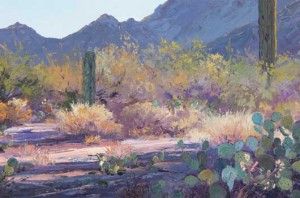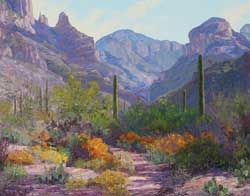Palette-knife painter Carol Swinney renders the western landscapes that she calls home
By Gussie Fauntleroy
When a blind man’s fingers can travel over a landscape painting and reveal nature’s beauty to sightless eyes, you know there’s something special about the art. That happened with a painting by Carol Swinney a few years ago during a show at the Old West Museum in Cheyenne, WY. Swinney, a plein-air painter who works exclusively with a palette knife, was approached by a man who asked if he could touch one of her highly textured paintings. He told her he had lost his sight but retained treasured memories of mountainous terrain.
As the man gently traced his fingers across the surface of Swinney’s painting, he described what he was “seeing”: the smooth expanse of a cloudless sky, then sharp mountain ridges and the sweep of canyon walls, the texture of bark on trees, and the delicate shapes of branches and leaves. He could even tell when his touch reached rocks on the creek bank and followed the path of the water itself.
“I’ll never forget that,” says Swinney, remembering the incident as she gazes out her studio window at the Santa Catalina range near Tucson, where she spends most of her time each winter. In late spring the artist returns to the ranch near Casper, WY, where she grew up and has lived for most of her life.
That a blind man could discern nature’s forms in a painting is because Swinney applies paint with a palette knife instead of a brush. For nearly 30 years she has honed her technique, which produces countless delicately shaped ridges and fine points of textured paint. For the sighted viewer, these catch and reflect light, adding depth and dimension to the already exceptional representational quality of her art.
“With a brush you can create thick impasto, like Walt Gonske does in his landscape painting, where you see the heavy brush strokes. It’s wonderful, just different from my work,” she explains. “With my paintings there are more flat, shiny, smooth parts and also ridges and lots of tiny points where the knife draws the paint up. The textures catch the light in different ways. I like the fact that you can actually make some of the textures look like objects in nature.”
Swinney’s mastery of palette-knife painting has earned the admiration of collectors, galleries, fellow artists, and exhibition juries in recent years. Among numerous honors, she has received three best of show and four people’s choice awards. She took home awards of excellence from the 2009 Nomadas Del Arte show at Southwest Gallery in Dallas and the 2008 Oil Painters of America Western Regional Exhibition. Her paintings have hung in such venues as the Gilcrease Museum in Tulsa, OK, and the National Museum of Wildlife Art in Jackson, WY. And among the prestigious societies she’s been invited to join, she was recently inducted into the Mountain Oyster Club in Tucson as an honorary artist member.
As a native of the wide-open West, Swinney takes pride in her independence and says she sees herself as having “always been a little different.” Still, she never intended to embark on the challenging artistic path of replacing the paintbrush with a knife. It happened by chance, and not all at once. Yet painting with a palette knife turned out to be the most significant development in her career.
In the early 1980s, after studying art at the University of Wyoming and painting primarily cowboy and equine subjects, she became intrigued with the work of acclaimed western landscape painter Bill Freeman. She saw something exciting and unusual in his art and decided she wanted to study with him, unaware that he worked exclusively with a palette knife. Freeman, based in Jackson, WY, agreed to share his knowledge.
Although the young part-time artist knew she would be painting en plein air, she soon discovered Freeman also expected her to employ the same tools he used. Undaunted, she watched and learned. “I was fascinated with his technique and how he was getting all those effects with the knife,” she recalls. “For my first experience using the knife, he gave me one of his paintings to copy as closely as I could by examining his strokes and colors.”
It was a difficult task. But Swinney persisted, gradually mastering techniques unlike anything she had done with a brush. For years she spent part of each summer painting with Freeman on location in Wyoming’s Grand Tetons. For a few weeks in the winter the two artists painted in the Arizona desert near Scottsdale. Swinney also studied extensively with wildlife and landscape painter Greg McHuron.
From these two “extremely generous” mentors, Swinney absorbed different elements of painting and art instruction. She wielded a brush when painting with McHuron and a palette knife whenever she set up her easel alongside Freeman. For a while she used both tools. With wildlife imagery, for example, an animal’s fur and fine details were rendered with a brush, while the surrounding landscape was created with a knife.
Eventually wildlife disappeared from Swinney’s art, except as occasional background figures. Her focus today is purely landscape, which she paints exclusively with palette knives. “Studying with both of them was good, because I didn’t want to paint exactly like Bill, and Greg is a master of color and design,” she notes. “I blended what they taught me and developed my own style.”
But Swinney needed no mentor when it came to perceiving and appreciating the western landscape.
Growing up on her grandparents’ 11,000-acre cattle ranch near Casper, she came to know and love the mountains, canyons, meadows, and never-ending Wyoming sky. One meadow in particular was a favorite spot when she was young—and it still is. The wetlands-dotted valley is home to waterfowl, raptors, foxes, deer, and antelope. “There are so many antelope that you’d think I raise them!” she quips, bright laughter reflecting a spirited, enthusiastic personality.
Along with nature, the other constant in Swinney’s life has been art. One of her great-great uncles in England was an accomplished artist, a grandmother painted landscapes and portraits, and Swinney’s mother was a skilled painter. Swinney’s own earliest memories are of drawing the animals around her. “As long as I can remember, being an artist is all I ever wanted to do with my life,” she declares. “Never once did I change my mind.” Her inherent talent was supported and enhanced through private art lessons as a child. “My mother, more than anyone, encouraged me in art early on.”
In 1997, following a divorce, Swinney decided to funnel her artistic passion into painting full time. “I knew I wanted to live, eat, and breathe art, to really immerse myself in the art world,” she says. Among the accolades she has received since then, one experience stands out in her mind. A few years ago a painting she did of the Grand Canyon, titled BATTLESHIP POINT, was part of a museum show that also included works by many painters Swinney had long admired. During the opening reception, several renowned landscape artists approached her and commented favorably on her work. “It was very satisfying to feel that I had come that far,” she observes. “It made me feel like I was on the right track.”
Another high point in the artist’s life was finding the perfect home and studio in Tucson to serve as her base during the winter months. There she enjoys exploring and painting her other favorite landscape, the Sonoran Desert. In imagery such as THE PASTEL DESERT, with cactus and mesquite against a backdrop of the Tucson Mountains, she expresses her visual attraction to the desert Southwest. “Desert colors are lighter—shades of pink, peach, and lavender,” she explains. “The variety of colors and shapes in the desert is just amazing.”
After purchasing her Tucson house five years ago, Swinney learned that it had burned to the ground and been rebuilt in the mid-1980s. With the new construction came a large, high-ceilinged studio, complete with a wet bar, a bathroom, and a storage room. Swinney installed her art supplies, some of her extensive collection of western and Native American art, and a single bed. While the house has a lovely master suite, she has never slept in it, instead spending her nights in the studio, where she truly does eat, sleep, and breathe art.
“People think it’s crazy, but I don’t care,” she smiles. “The studio is where I want to be. I live with my art—what I’m working on is the first thing I see when I wake up and the last thing when I go to bed.”
Dossier
Representation
Astoria Fine Art, Jackson, WY; Pitzer’s Fine Arts, Wimberley, TX; Scottsdale Fine Art, Scottsdale, AZ; Southwest Gallery, Dallas, TX; www.carolswinney.com.
UPCOMING SHOWS
Two-artist show with Julee Hutchison, Scottsdale Fine Art, January 15-31.
American Miniatures, Settlers West Galleries, Tucson, AZ, February 13.
Cowgirl Up! Art From the Other Half of the West, Desert Caballeros Western Museum, Wickenburg, AZ, March 26-May 2.
The Russell: The Sale to Benefit the C.M. Russell Museum, Great Falls, MT, March 18–20.
Featured in January 2010







